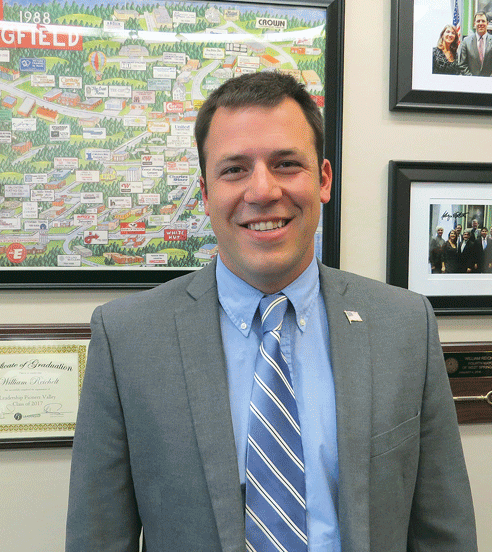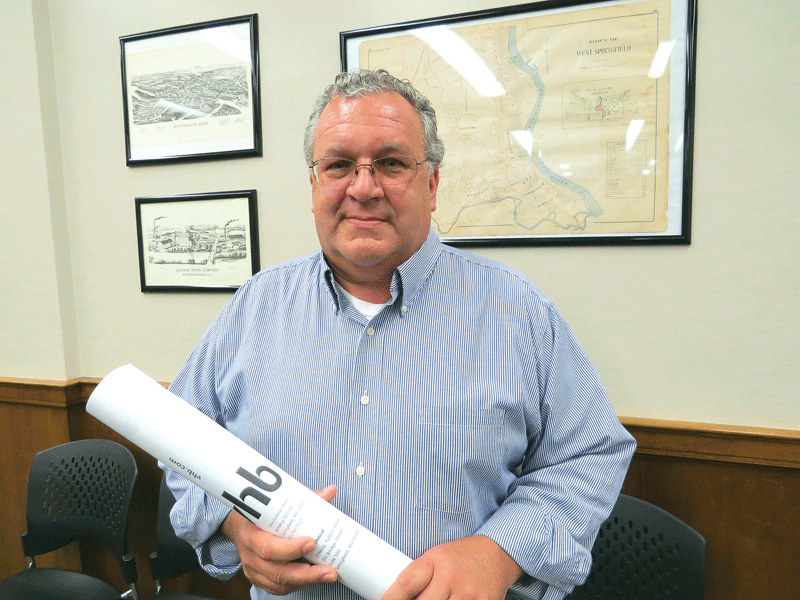West Springfield Aims for Balance, Smart Growth
Community Spotlight

Mayor Will Reichelt says West Springfield is seeing a good deal of adaptive reuse of commercial and industrial properties, a necessity in a community that is land-poor.
Will Reichelt says he was only 15 when he started working at the Donut Dip on Riverdale Street.
His father arranged an introduction with the owner, a fellow Rotarian, and just a few days later, Will was working behind the counter and occasionally injecting filling into jelly donuts.
“I’m not sure it was all legal, but … I sure do miss that 15-year-old body,” said the mayor, now all of 31 and in his second year at the helm of the city where he grew up. “I could eat all the donuts I wanted and never gain an ounce.”
Reichelt spent two and a half years at that Donut Dip, or roughly until he graduated from high school. He remembers at least two things from his time on Riverdale: one was that the busy thoroughfare was seemingly in a constant state of change, and the other was that the Donut Dip wasn’t.
“And it’s still the same — hasn’t changed at all,” said the mayor, who obviously still visits the establishment on occasion. As for Riverdale Street, it remains in that consistent state of change, and for many reasons.
The two major highways that feed traffic onto it — the Mass. Turnpike and I-91 — are the two biggest, because major retailers — and that includes the slew of auto dealers doing business on that stretch — covet such accessibility and will go to great lengths to take full advantage of it. Another is the fact that West Springfield is, to use a term that municipal leaders hate to use, ‘land-poor,’ meaning most developable real estate has been developed already.
All this leads to a term that those involved in economic development are much more fond of using — ‘adaptive reuse,’ which is happening, in one form or another, in seemingly every corner of this city of roughly 28,000. Some examples:
• Buildings within the former Gilbarco complex on Union Street have been repurposed by U-Haul as home to everything from self-storage units to a facility for servicing trucks within the huge fleet;
• The former St. Ann’s Church on Memorial Avenue, razed more than five years ago, has been transitioned into a retail center and home for Florence Savings Bank’s first branch in Hampden County; city officials are still awaiting word on other tenants for that facility;
• A Chipotle restaurant has opened on the site of what was once home to a Jiffy Lube on Memorial Avenue, adding to the already impressive number of eateries on the street that is also home to the Big E;
• Staying on Memorial Avenue, several buildings were razed there and the real estate consolidated by Fathers & Sons to create new, state-of-the art dealerships for Audi and Volkswagen, which opened early this year;
• A former billiard parlor on Riverdale Street has been razed to make way for a new, 121-room Marriott Courtyard hotel that will again alter the landscape on that street; and
• Further north on that strip, a residential property has been acquired by Balise Motor Sales with the intention of adding a car wash to the extensive portfolio of facilities it has on or near Riverdale.
One of the good things about West Springfield is that we are, literally, at the crossroads of New England. Redevelopment of empty parcels pretty much takes care of itself, because people want to be along Riverdale Street, Memorial Avenue, or in West Springfield, because it’s so easy to get to.”
There are many other examples from the past several years or that are now on the drawing board, said Reichelt and Douglas Mattoon, director of the city’s Department of Planning and Development, as they described two of the key planks within the community’s economic-development strategy — making the very best use of the land that is available, even if that means knocking something else down to make those efforts possible, and taking full advantage of its enviable geographic location, which the mayor summed up effectively.
“One of the good things about West Springfield is that we are, literally, at the crossroads of New England,” he said, borrowing language used by more than a few of the retailers with a presence in his city. “Redevelopment of empty parcels pretty much takes care of itself, because people want to be along Riverdale Street, Memorial Avenue, or in West Springfield, because it’s so easy to get to.”
To fully capitalize on all this, the city has embarked on the first major effort to update its zoning in a half-century.
“We put together a zoning-review committee, and they’ve been working for four or five months now,” said Reichelt. “They’re literally taking our zoning ordinances from page 1 to page 200 and whatever, and reviewing everything with an eye toward the next 50 years and what will enable the town to move forward.”
West Springfield at a glance
Year Incorporated: 1774
Population: 28,391 (2014)
Area: 17.49 square miles
County: Hampden
Residential Tax Rate: $16.99
Commercial Tax Rate: $22.21
Median Household Income: $54,434
Median family Income: $63,940
Type of government: Mayor; Town Council
Largest employers: Eversource Energy; Harris Corp.; Home Depot; Interim Health Care; Mercy Home Care
* Latest information available
Overall, said Mattoon, West Springfield continues to work toward two goals that are at or near the top of every municipality’s to-do list — achieving balance between residential and commercial development, and smart growth.
For this, the latest installment of its Community Spotlight series, BusinessWest takes an in-depth look at a community that has always been an attractive mailing address for businesses, and continues to be a destination.
Roads to Progress
While Riverdale Street and Memorial Avenue, the two real entranceways to West Springfield, if you will, provide the most visible evidence of the growth and constant change that place within the city, there are examples in virtually every corner, said Mattoon.
He used an always-effective barometer — building permits issued for both residential and commercial projects this year — to get this message across.
“More than 1,200 permits have been issued,” he noted. “There is some new-home construction and lot of home-improvement projects, and the commercial side of the ledger has really taken off. Our site-plan reviews and zoning board applications are up 52% from where we were last year.
“We’ve had a lot of activity come before us,” he went on. “Not only on the Riverdale corridor, but also on the Memorial Avenue corridor and even the Route 20 corridor, which is a minor corridor going through the center of town.”
Summing up what he believes those permits show, Mattoon said a number of businesses in the community are doing quite well and are in expansion mode. Meanwhile, others want to also take advantage of being at those aforementioned crossroads.
In that former category are a number of businesses across a host of sectors, including Titan USA, a maker of high-speed steel and cobalt cutting tools, which is again expanding its facilities on Baldwin Street; several retailers, including Food Bag, Cumberland Farms (both on Route 20), and Wendy’s, which built a new facility on the site of a former Arby’s on Riverdale Street; U-Haul; and even Costco, which is looking to add gasoline to the seemingly endless list of products it sells from its location in the Riverdale Shops — a project that has been in the works for years and is now before the Planning Board.
In the latter category, meanwhile, is the new hotel on Riverdale, Balise’s car-wash project, a new Pride Store on Riverdale that will replace a smaller facility the company operated, and some new residential developments, including an ambitious project adjacent to Springfield Country Club called Piper Green.

Doug Mattoon says West Springfield strives for smart growth and a balance between commercial and residential growth.
While all this is going on, city officials are hard at work on several fronts that, collectively, fall into the categories of facilitating more of these types of developments while also enabling the community and specific neighborhoods within it to absorb such growth without negatively impacting traffic and overall quality of life.
And these efforts take a number of forms as well. They include the zoning overhaul, which Reichelt said is needed and long overdue, as well as close examination of the types of businesses the city wants to attract.
“Much of our focus has been on Westfield Street [Route 20], the center of town, how we encourage more business to come there — not that there’s a lack of business there,” he explained. “But is what’s there what we want, and if it’s not, how do we get what we want there?”
Mattoon agreed, and said such efforts, which fit the general description of ‘smart growth’ efforts, intersect with the many initiatives involving adaptive reuse.
As an example, he noted ongoing initiatives to repurpose many of the industrial and distribution facilities in the Merrick and Memorial sections of the community, including the Gilbarco complex, where gasoline pumps were manufactured decades ago.
“Such adaptive reuse requires flexibility and our ability to analyze the proposed alternative uses, and make sure they fit with the general character of the neighborhood, traffic, pedestrian safety, and so forth.”
It also includes infrastructure improvements, such as those slated for Memorial Avenue. These include the long-discussed and long-anticipated replacement of the Morgan/Sullivan Bridge over the Westfield River (the border with neighboring Agawam) and a comprehensive reconstruction of the full length of Memorial Avenue.
That state-funded project will commence when the bridge project is completed, said the mayor, estimating that will be in 2022.
Currently at the 25% design stage, the initiative calls for creating four lanes, with designated left-turn lanes and bike lanes as well, between the Memorial Bridge rotary and Union Street, and then three lanes between Union Street and the Morgan/Sullivan Bridge.
The so-called Complete Streets project, so-named because it factors in cyclists and pedestrians as well as motorists, is designed to bring smoother traffic flow to a street that has seen exponential growth over the past few decades, has struggled to handle the higher volumes of traffic, and is especially challenged during the Big E’s 17-day run every September.
“I think the Route 147 [Morgan/Sullivan] bridge project is really going to help with the traffic situation on Memorial Avenue, especially during the Big E,” said Mattoon. “That’s where we’re really seeing traffic back up — those intersections just on the other side of the bridge in Agawam.”
Meanwhile, returning again to Riverdale Street, Costco’s proposal, which calls for a number of gas pumps and a convenience-store-like facility, will require some changes to that thoroughfare, said Mattoon.
He noted that the intersection of Riverdale and Daggett Drive must be modified to handle traffic concerns raised by the project. Specifically, a southbound exit out of Daggett Drive would be added, explained, noting that this is another example of how the town is working to encourage new business ventures while also taking steps to minimize the impact from such growth on specific streets and neighborhoods.
To-Dough List
Mayor Reichelt worked at the Donut Dip half a lifetime ago. By most accounts, including his, there has been little change at that location since the start of this century.
But there has been change all around it on Riverdale Street — and also on Memorial Avenue, Route 20, Baldwin Street, and every other corner of the city — and it is ongoing.
This is life at the crossroads of New England. Those highways create opportunities, challenges, and a delicate balancing act, one that Reichelt and his team at City Hall continue to master.
George O’Brien can be reached at [email protected]




